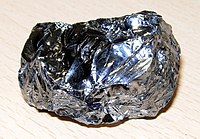
Photo from wikipedia
In the commonly used existing silicon-on-insulator microelectromechanical systems (MEMS) process, a silicon-oxide-silicon sandwich structure in the sensor device creates parasitic capacitance, which reduces the charge sensitivity. In this letter, for… Click to show full abstract
In the commonly used existing silicon-on-insulator microelectromechanical systems (MEMS) process, a silicon-oxide-silicon sandwich structure in the sensor device creates parasitic capacitance, which reduces the charge sensitivity. In this letter, for the first time, we demonstrate a vibrating-reed-based electrometry system with high sensitivity and resolution in the silicon-on-glass (SOG) MEMS process. In this letter, we utilize a glass substrate instead of silicon to ameliorate charge sensitivity by reducing the parasitic capacitance. An improved preamplifier circuit topology incorporating with the proposed sensor shows a sensitivity of
Journal Title: IEEE Electron Device Letters
Year Published: 2018
Link to full text (if available)
Share on Social Media: Sign Up to like & get
recommendations!